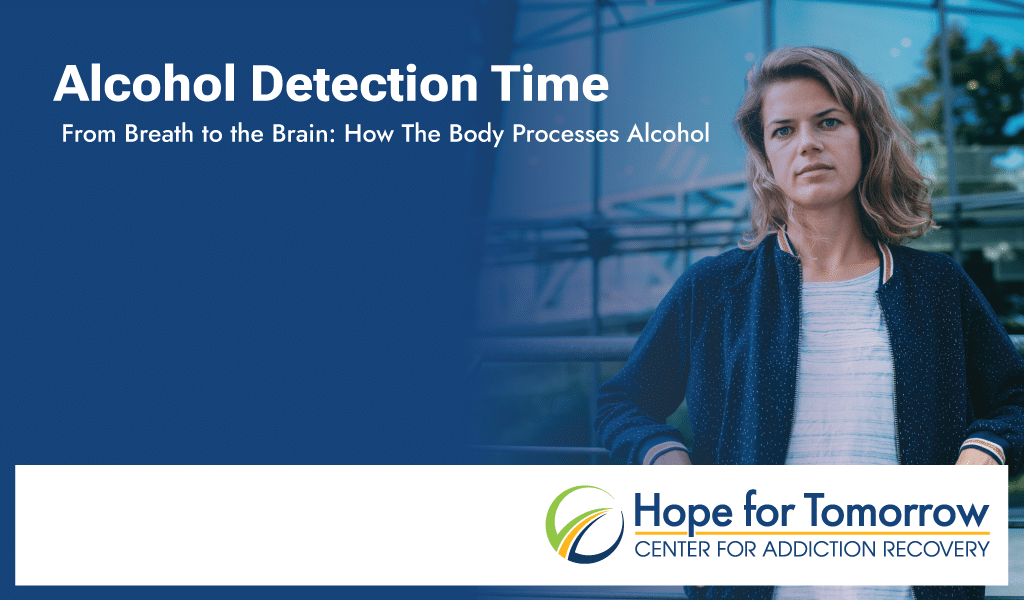

Four drinks in, and you fall asleep. Thankfully, it’s just your friend’s house party, so you feel perfectly safe. When you wake up, you feel perfectly sober, too. The party has thinned out, so you should probably go home. You hesitate, though. Is it safe to drive home? You don’t feel drunk at all anymore, but would it be safer to spend the night at your friend’s house? How long does alcohol stay in your system?
It’s an understandable question. 14% of West Virginians self-reported excessive drinking as of 2020, so it’s a relevant question, too. This is especially true for people with alcohol use disorders, who often find their lives revolving around alcohol and may worry about the results of a urine test. Hope for Tomorrow empowers people with alcohol use disorder to work toward recovery.
Whether you’re someone with an alcohol use disorder or you’re concerned about a loved one, it’s helpful to know how long alcohol sticks around in your system.
When you drink alcohol, it travels down your esophagus and settles in your stomach like any other drink. Alcohol is mainly absorbed into the bloodstream through your stomach tissue and upper small intestine tract. Once in your blood, alcohol travels throughout your body, including your lungs, and eventually reaches your brain. This brings on those well-known feelings that come with intoxication if you drink enough.
The liver does the heavy lifting when it comes to processing alcohol. Enzymes break up alcohol in your liver, and help it expel the toxins that come with it from your body. Your body can process about one drink per hour, though this can vary a little from person to person based on a variety of factors.

The answer to this question depends on what you define as “your system.” The liver processes about one drink per hour, which helps avoid intoxication, but that isn’t enough for alcohol to completely leave your body or bloodstream.
Alcohol is present in your breath, urine, saliva, and hair for longer than it stays in your bloodstream, and the amount of time in each case can vary greatly based on a variety of factors. Here’s a general estimate of how long alcohol will show up in a test of any of the following:
While the liver is largely responsible for helping you excrete alcohol, a small amount leaves your body through your sweat, breath, and urine.
How long alcohol is detectable in your system depends on what part of the body you check, and there are additional influences on how long alcohol stays in your system. These different factors include:
The feelings that come with intoxication are unreliable indicators of how much alcohol is actually in someone’s system. Thankfully, there is a standard way to measure the amount of alcohol in your system: testing your blood alcohol concentration (BAC).
Your BAC percentage represents how much of your blood is pure alcohol. A BAC of .1 would mean .1% of your blood is alcohol. .08 BAC or higher is the level that would get you a DUI in West Virginia. .45 BAC is usually fatal. However, how BAC levels impact you varies from person to person, just as different factors influence BAC itself.
It’s important to note that driving skills can be impaired at as low as .02 BAC. Having a BAC of .02 is possible for most people after only one drink. Remember this fact next time you think about driving yourself home after a night of drinking.
When you think of testing for alcohol in someone’s system, you may think of a breathalyzer first. Breathalyzers measure BAC by measuring the amount of alcohol concentrated in your lungs, which relates directly to the amount of alcohol in your blood. 2,100 milliliters (ml) of breath is comparable to about 1 ml of blood, as far as testing BAC goes.
Blood tests are also a common way to test for BAC, and so are urine tests.
Most of the alcohol tests available measure BAC through EtG and ethanol levels, but it’s especially true for urine tests.
EtG urine tests measure ethyl glucuronide, a chemical the liver produces as it processes alcohol. EtG stays in the body for a long time – up to around five days after consuming alcohol. Subsequently, EtG tests aren’t the best for detecting recent alcohol use. They’re incredibly accurate if you need to know if someone who should be abstinent from alcohol drank within the past few days, but aren’t ideal for DUIs, for example.
Ethanol urine tests are better for testing more recent BAC levels, but aren’t as accurate as EtG tests. Ethanol can appear in urine 45 minutes to an hour after drinking alcohol, and then remain detectable for around 12 hours afterward. A problem with ethanol urine tests is that the results “lag behind” your actual BAC levels. Because of this, sometimes whoever is administering the test will require you to take another one 30 minutes later.
Ethanol also occurs naturally due to bacteria, not just alcohol. This means if you have a health condition, or the urine sample is left out where bacteria can grow in it, you may receive a false positive on the test.
You may have heard that drinking more water, taking a shower, eating something, or many other tricks would help you “sober up” faster. Unfortunately, even if those things may make you feel more alert, they don’t impact your BAC levels. The only way to really sober up is by giving your liver time to process the alcohol in your system.
You may be familiar with the short-term effects of alcohol: relaxation, lowered inhibitions, slurred speech, impaired judgment, loss of coordination, memory problems, headaches, and nausea, just to name a few. You also probably know about hangovers and the symptoms that come with them several hours after drinking.
The long-term effects of alcohol are a little less obvious, but it might be even more important to know them. The impact alcohol has on your body long-term depends on the amount of alcohol you drink and how frequently you drink, but these changes are all possible due to alcohol:
The best way to avoid these long-term effects is to drink responsibly and in moderation. However, for people with alcohol use disorder, that’s incredibly difficult without help.

If you’re all too familiar with having high BAC levels, and some of those long-term effects of drinking alcohol are cropping up for you, it’s a good time to reconsider your relationship with alcohol.
If you feel like your drinking is out of control, and you’ve had trouble stopping no matter how hard you try, that’s a sign of alcohol use disorder. So is failing to stay within the limits you set for yourself, and consistently thinking about your next drink when you’re going about your day and tending to your responsibilities. If you have an alcohol use disorder, there’s nothing to be ashamed of. 29.5 million people in the United States had an alcohol use disorder in 2022, so you aren’t alone. You shouldn’t try to recover on your own, either. Instead, seek out alcoholism treatment, and change your life for the better.
Hope for Tomorrow services people with substance use disorders in the West Virginia area. Our team is passionate about bringing care to everyone who needs it. No matter who you are, if you’re seeking recovery, you have a place at Hope for Tomorrow. Give us a call at 877-679-8162 for more on finding treatment today for a brighter tomorrow.